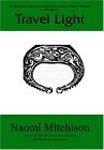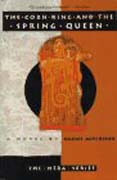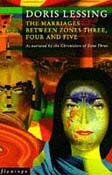When Naomi met Doris
If I’m in Edinburgh in early June, I try to go to the Meadows Festival. I usually take my Super 8 cine camera and film all the friends I meet. One day, I plan to splice all the sequences together.
Originally the festival was a community event with stalls from local organisations, corny competitions and local bands on the back of a beer lorry. Now it’s dominated by traders selling car-boot quality tat. There are usually a couple of decent secondhand bookstalls though.
 Last year I found a collection of essays about the ideological choices between Marxism and Christianity by Lancelot Hogben, a mid-twentieth century polymath who wrote popular books on science and politics. Inside the front page was Naomi Mitchison’s library plate.
Last year I found a collection of essays about the ideological choices between Marxism and Christianity by Lancelot Hogben, a mid-twentieth century polymath who wrote popular books on science and politics. Inside the front page was Naomi Mitchison’s library plate.
I’ve been a fan of Naomi Mitchison since the 1980s when Virago reissued her first novel, The Corn King and the Spring Queen, and the post-war Travel Light. Most of her books are out of print so I look out for them when browsing. That Easter, I’d been visiting a friend in Arundel, a dull English town, dominated by the ugly castle and uglier Catholic cathedral. However, in the Arundel Bookshop I found a first edition of Not by Bread Alone, one of Mitchison’s many works of science fiction. Its thin plot revolves around the global impact of a multinational corporation that forces genetically modified food on developing countries. The book is really badly written, the characters wooden and the dialogue stilted. All the same, it is based on plausible science and, for 1983, its themes are surprisingly prescient.
 Ten years before I first encountered Mitchison, my much missed friend Franki Raffles lent me Doris Lessing’s The Golden Notebook. Franki, who died in 1994, is deservedly remembered for her radical public photography, in particular Edinburgh’s Zero Tolerance campaign confronting male violence against women. In the early 1970s, the St Andrews University I joined was a time warp of tradition and conservatism. Those of a leftish persuasion could comfortably fit into a telephone box, so Franki’s robust feminism was a welcome sanity clause for me. We quickly discovered a shared addiction to the written word. She introduced me to Marcel Proust and Herbert Read; I lent her George Eliot and Günter Grass. Not all her household approved of my taste. Later, when Franki was farming on Lewis, her dog Gulliver chewed its way through my Penguin editions of Daniel Deronda and The Tin Drum.
Ten years before I first encountered Mitchison, my much missed friend Franki Raffles lent me Doris Lessing’s The Golden Notebook. Franki, who died in 1994, is deservedly remembered for her radical public photography, in particular Edinburgh’s Zero Tolerance campaign confronting male violence against women. In the early 1970s, the St Andrews University I joined was a time warp of tradition and conservatism. Those of a leftish persuasion could comfortably fit into a telephone box, so Franki’s robust feminism was a welcome sanity clause for me. We quickly discovered a shared addiction to the written word. She introduced me to Marcel Proust and Herbert Read; I lent her George Eliot and Günter Grass. Not all her household approved of my taste. Later, when Franki was farming on Lewis, her dog Gulliver chewed its way through my Penguin editions of Daniel Deronda and The Tin Drum.
After Franki’s introduction, I read Lessing voraciously, scouring bookshops for her novels, even tracking down the long out of print Retreat to Innocence in Reader’s Rest, a fine bookshop on Steep Hill in Lincoln. Franki wasn’t enthusiastic about science fiction but the feminist sensibilities of the Canopus in Argus series appealed to her. When The Women’s Press reissued Mitchison’s Memoirs of a Spacewoman in 1985 I lent my copy to Franki, who had growing doubts about Lessing’s politics; she commented wryly that Lessing’s science fiction must have been strongly influenced by Mitchison’s.
I don’t actually know when Mitchison and Lessing first met but they were both members of the 1950 Authors’ World Peace Appeal delegation to the Soviet Union. The AWPA was widely seen as a Communist Party front and proscribed by the Labour Party, which must have been problematic for Mitchison whose husband was a Labour MP. At that time, Lessing moved in Communist circles and, despite misgivings, was soon to join the Communist Party. In contrast, Mitchison was not a joiner: George Orwell included her on the list of untrustworthy intellectuals he secretly submitted to the government, but suggested that she was no more than a sentimental sympathiser of Communism.
In Leningrad they shared a room. Lessing plainly found Mitchison exasperating and embarrassing: in the second volume of her autobiography, Walking in the Shade, she describes her as being on the ‘right wing’ of the British group and patronising towards the Soviets. She recalls a speech Mitchison made in which she asked why the Soviet Union ‘had become hostile to Free Love’ and was no longer a ‘beacon of progress’. According to Lessing, when they discussed the journey twenty-five years later, ‘it was as if we had been on two different trips.’ In her 1981 travelogue Mucking Around: Five Continents over Fifty Years, Mitchison recalls that they ‘argued and argued’. Like Lessing, she comments: ‘Again I think that each member of the AWPA party saw what he or she expected or hoped to see; this is clear from our reports.’
 Nonetheless, despite their differences, the two women remained friends. Indeed, Lessing credits Mitchison with ‘breaking new ground for women in the Thirties’, particularly with The Corn King and the Spring Queen.
Nonetheless, despite their differences, the two women remained friends. Indeed, Lessing credits Mitchison with ‘breaking new ground for women in the Thirties’, particularly with The Corn King and the Spring Queen.
This under-rated novel recounts the travails of its pre-Christian heroine, Erif Der, and hero, Tarrik; the ritual leaders of Marob, a frontier state on the Black Sea between Greek enlightenment and Asian barbarism. In Marob, society revolves around the ancient traditions of the Corn King and his consort the Spring Queen, whose seasonal practices guarantee the fertility of the soil and the success of the crops. Marob’s rugged primitive communism is shattered by the arrival of a Greek Stoic who converts Tarrik, breaking his magic. Tarrik goes to Greece and is followed by Erif Der, whose magic now only works when she is amongst those who share her beliefs, mostly women. Eventually, Tarrik’s Spartan allies are defeated by the Macedonians and flee to decadent Egypt. Here the Marobians again encounter the old magic, this time in the rituals of Isis and Osiris. Finally, healed and reunited, in the face of the murder of the Stoics, Tarrik and Erif Der return to Marob, paying little attention to rumours of some distant upstart city called Rome.
It is hard to convey the richness of the descriptions of these lands and their peoples. In researching her material Mitchison drew heavily on the collections of ancient artefacts in the British Museum and on James Frazier’s monumental taxonomy of magic and religion, The Golden Bough.
One of the attractive features of The Corn King and the Spring Queen is that its characters talk in down to earth language. There is no attempt to convey a sense of the past through the use of archaisms. However, it is dated by the use of contemporary slang – a foolish person is a ‘silly goose’ and a failed relationship is ‘smashed up’. Unlike much historical fiction, its characters do not deliver tiresome lectures when exploring the deep philosophical themes in which the book is rooted. Rather, they discuss how these ideas might impact on their day to day lives. Much of Lessing’s writing shares these strengths: the playing out of huge ideas through ordinary lives and the sense that characters might be people that you or I could meet.
There are curious echoes between The Corn King and the Spring Queen and Lessing’s The Marriages Between Zones 3, 4 and 5, the second in the Canopus in Argos series, written almost fifty years later and set in an unknown time and  place. Al*Ith is the Queen of Zone 3, a land of peaceful and cultivated people who live in a heightened state of awareness of each others’, and their animals’, needs. Al*Ith is ordered by the Providers to marry Ben Ata, the soldier-king of the militaristic and hierarchical Zone 4. It seems that, to renew the equilibrium of the Zones, Al*Ith must be made more individual by Ben Ata, and Ben Ata more reflective by Al*Ith. In turn, Ben Ata must marry Vahshi, the Queen of the warrior-nomads of Zone 5. Eventually, Al*Ith ascends to Zone 2 whose population has merged almost to pure spirit, manifest individually as flames.
place. Al*Ith is the Queen of Zone 3, a land of peaceful and cultivated people who live in a heightened state of awareness of each others’, and their animals’, needs. Al*Ith is ordered by the Providers to marry Ben Ata, the soldier-king of the militaristic and hierarchical Zone 4. It seems that, to renew the equilibrium of the Zones, Al*Ith must be made more individual by Ben Ata, and Ben Ata more reflective by Al*Ith. In turn, Ben Ata must marry Vahshi, the Queen of the warrior-nomads of Zone 5. Eventually, Al*Ith ascends to Zone 2 whose population has merged almost to pure spirit, manifest individually as flames.
Thus, both novels are rooted in the contradictory dynamics of cultural transformation. Another strong connection lies in the authors’ senses of their native landscapes.
By and by the path disappeared altogether; he crossed a ridge with boulders and deep, dampish hollows between them; when he stumbled his fingers felt flower stems. He dipped into a hollow of utter blackness, then came up again, sometimes through scrub and sometimes over scree or bare rock. It was much colder. He got up to the level where snow had been earlier that year. He wanted the night never to end; he could not bear that dawn should come, light and beauty, without her…
There was a soft blueness about everything – ahead of them, where the road turned around a clump of rocks, a bluish air that seemed to beckon them on. The hills here were purple, and the vegetation had a blue tinge. Above the turn of the road ahead the sky was blue not only with distance, but because the air everywhere was blue in essence. And small purple mists lay among the trees…
The first passage is Mitchison’s description of the Aegean; the second, Lessing’s border between Zones 2 and 3. Either could be Glencoe or the High Veldt.
For me, these novelists share a strong sense of place, of change, and of the ordinary rooted in the extraordinary. They also share a passionate concern for the  oppressed, which shines out of their fiction. Perhaps their biggest difference lies in their treatments of violence. Mitchison’s ancient world is rooted in Frazier’s depiction of harsh human rituals of life and death, in sympathy with natural cycles of decay and rebirth, that transcend the otherwise very different Marobian, Spartan and Egyptian societies. Lessing evokes societies where violence is learned and socialised, an altogether more modern sensibility.
oppressed, which shines out of their fiction. Perhaps their biggest difference lies in their treatments of violence. Mitchison’s ancient world is rooted in Frazier’s depiction of harsh human rituals of life and death, in sympathy with natural cycles of decay and rebirth, that transcend the otherwise very different Marobian, Spartan and Egyptian societies. Lessing evokes societies where violence is learned and socialised, an altogether more modern sensibility.
While both authors have challenged and engaged me, of the two I think I prefer Mitchison. When The Corn King and the Spring Queen first came out, it was heralded by Winifred Holtby as being of Nobel Prize calibre. In my opinion Holtby’s praise was well merited: The Corn King and the Spring Queen is one of the defining works of Scottish magic realism.
Copyright Greg Michaelson 2005

Comments